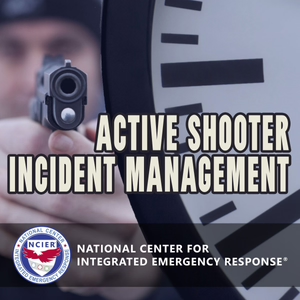
C3 Podcast: Active Shooter Incident Management
C3 Pathways
All episodes
Best episodes
Top 10 C3 Podcast: Active Shooter Incident Management Episodes
Goodpods has curated a list of the 10 best C3 Podcast: Active Shooter Incident Management episodes, ranked by the number of listens and likes each episode have garnered from our listeners. If you are listening to C3 Podcast: Active Shooter Incident Management for the first time, there's no better place to start than with one of these standout episodes. If you are a fan of the show, vote for your favorite C3 Podcast: Active Shooter Incident Management episode by adding your comments to the episode page.
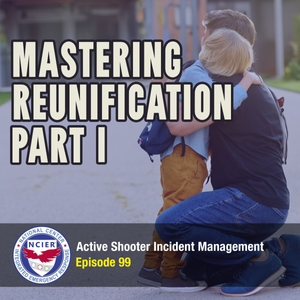
Ep 99: Mastering Reunification Part 1
C3 Podcast: Active Shooter Incident Management
12/30/24 • 29 min
In today’s podcast we discuss the importance of reunification training and exercises for schools and public safety organizations. John-Michael Keyes, Stacy Avila, and Kevin Burd from the I Love U Guys Foundation speak with Bill Godfrey, focusing on their respective approaches to reunification training.
The podcast highlights the complementary nature of different training approaches and emphasizes the importance of collaboration between schools and public safety organizations in preparing for and executing reunification procedures.
Key Points:
Training Programs
- The Standard Reunification Method (SRM) by the I Love You Guys Foundation
- School Safety and Violent Event Incident Management (SSAVEIM) by the National Center for Integrated Emergency Response
- Reunification Exercise (REx) class
Important Aspects
- Simulation of realistic scenarios without recreating the triggering event
- Collaboration between school staff and public safety personnel
Benefits of Training
- Reduces stress and anxiety about reunification
- Provides insight into the complexities of the process
- Helps educators understand the public safety response timeline
View this episode on YouTube at https://youtu.be/FspwCcTGuxQ
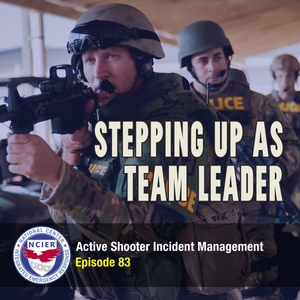
Ep 83: Stepping up as Team Leader
C3 Podcast: Active Shooter Incident Management
06/03/24 • 31 min
If you are one of the first arriving officers at an active shooter incident, you may have to step up as team leader. You’ll be making critical decisions to accomplish the mission. You can prepare for leadership, just as you prepare for entry – put yourself in the role and plan how you would handle it.
View this episode on YouTube at https://youtu.be/jHyK3HU5JKY
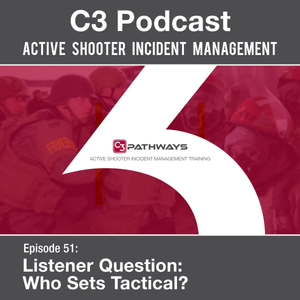
Ep 51: Listener Question - Who Sets Tactical?
C3 Podcast: Active Shooter Incident Management
09/05/22 • 24 min
Episode 51: Listener Question - Who Sets Tactical?
This week are live on the road with the ASIM team in New York City. Today we are answering a former ASIM student's question on "Who sets tactical with only three or four officers on duty?"
Bill Godfrey:
Bill Godfrey: Welcome to the Active Shooter Incident Management Podcast. My name is Bill Godfrey, your podcast host. I have with me today, three of the C3 instructors, Kevin Burd, our Director of Training. Kevin, thanks for being here today.
Kevin Burd:
Thanks for having me, Bill.
Bill Godfrey:
All right. And we got Jason Kelley. Jason, good to have you here.
Jason Kelley:
Thank you, sir.
Bill Godfrey:
Or, as we call him, Slide Deck. And we have Coby Briehn. Coby, welcome back.
Coby Briehn:
Thanks for having me.
Bill Godfrey:
All right, so today we got something a little bit different for our topic today. We actually have an audience question. The question comes from a former student of ours from an ASIM course, and he says, "I work for a university police department in a city of about a hundred thousand. Our active shooter instructors have a question about setting up tactical. If we only have three or four armed officers on duty, such as the weekends or second shifts or third shifts." And the question is, "if we only have three officers to respond, do we send in a two-officer contact team and keep the third for tactical to manage the city and county officers who respond into the campus? Or do we give up tactical to have our third officer make entry and search for the threat and let the city officer take the lead on running tactical operations?" He goes on to say, "There's been some discussion both ways. There's not a consensus." And he is asking if we could provide a recommendation and the reasoning why we would recommend that as our course of action.
So, a number of interesting things here. He's concerned about the shifts where they've only got three or four officers on duty. Okay, so that's first of all. So, obviously, they got backup coming from the city and the county. I'm guessing one of the questions you guys have is, what's our response time for the city and the county? Let's assume the city's going to be right there because the university's in the city, a couple minutes, they're there pretty quick. And for the county, let's say it's a little bit longer, a little over 10 minutes for that. Before we get rolling on thoughts, does anybody have any other questions that they want to ask about it?
Kevin Burd:
My first question would be, what is the standard policies and procedures that they would operate under? Is everybody who's responding under the same guidance? Is it a countywide response plan? Is it three individual plans? That would probably dictate some of our answers or thoughts on this.
Bill Godfrey:
I think those are both great questions. And actually, I asked him a couple of those questions and he did give me some additional information. He said that they all three have some common training, but they have different policies and procedures. The university police has adopted the ASIM process. The others haven't gone quite that far. They've had to negotiate some things, so instead of tactical taking up the position and doing staging, they have tactical go to the door and control everything at the door. The other thing that I think is important to mention, is they do not have compatible communication systems. The university police doesn't have the ability to go to the city channels and the city police do not have the ability to go to the university channels. All right? Any other questions before we start talking or who wants to lead off?
Jason Kelley:
Oh, I'll lead off. This is Jason. I'll lead off. I guess my first concern is, three agencies on three separate channels. If you're going to place a university officer outside the tactical as that third officer, and sending to his contact teams to stop the killing. To me, that probably makes sense. So, they have direct line of communication from tactical to the interior units, additional resources responding. My opinion is, you need to then send a city and county to tactical, to that university officer, so now we have communications for additional responding officers.
Bill Godfrey:
All right. That's a tough call, right? I mean, you've only got three or four gun-toters to begin with, we're going to minus one to keep them outside to try to coordinate the rest of this response. Coby, what do you think? Two going in real quick with hopefully a couple more coming in a few minutes?
Coby Briehn:
Right. All good considerations. Off the top of my ...
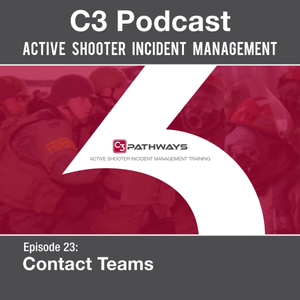
Ep 23: Contact Teams
C3 Podcast: Active Shooter Incident Management
03/22/21 • 34 min
Episode 23: Contact Teams
A discussion of Contact Teams, the role of the first arriving law enforcement officers, and the professionalism required to shoulder the immense responsibility of responding to an Active Shooter Event.
Bill Godfrey:
Welcome back to the next installment of our podcast. Today, we are going to be revisiting a subject that we have not talked about in years on the podcast, and that's contact teams. Today I have with me, Billy Perry, a retired detective and EOD from Jacksonville Sheriff's Office. While he was there, also part of their SWAT team, their dive team, the Marine unit. And even though he is technically retired, not really...
Bill Perry:
Not really.
Bill Godfrey:
Not really...
Bill Perry:
Not really.
Bill Godfrey:
... because you're still training with them...
Bill Perry:
I am, 36 hours a week.
Bill Godfrey:
... on an almost daily basis. Also joining with us, we have Harry Jimenez, who retired from Homeland Security Investigations after 30 years with DHS at the federal level, and is now serving as the deputy chief for Dimmitt County Sheriff's Office. Harry, welcome. Thanks for taking the time.
Harry Jimenez:
Thank you, Bill.
Bill Godfrey:
All right, so Billy, I know that this is a subject that is passionate and dear to your heart. Why? Why so?
Bill Perry:
I think this is a very difficult topic. It's a challenging topic. It's one that we approach with great reverence, with great seriousness, with great thought. And we want to come at this from a position of knowledge and a position of seriousness and with as much reverence as we can muster for it. And it is the contact team. And what does a contact team do and what is their primary job? And in any active incident, our two objectives is to stop the killing and stop the dying. And our community, the law enforcement community, for a long time was really, really, really good at that. And we're still okay at it, but we're we're having challenges or we're have been some times when we have been less than... Suboptimal, we've been suboptimal. And I think with this, and part of it is we're going through and institutional inertia paradigm shift, frankly, where I think some things are changing. And at the end of the day, we have a responsibility to stop that and there are challenges with that.
Bill Godfrey:
You say suboptimal. Without getting into specifics of incidents, can you give me some examples of the types of behavior you're talking about that's not really what we want.
Bill Perry:
Well I think, and we were talking about it-
Bill Godfrey:
Or the reverse of that, Billy. Give me the examples of what we do.
Bill Perry:
Right, exactly. That's where I was going to go with that. You read my mind. We were just talking about it, Harry and I, and one of the things is knowing what our mission is. And that's part of the issue is, as law enforcement we've had mission creep. And what I mean by that is, we're social workers and we're real estate landlords, and for we're civil people and we're traffic crash investigators, and we're... And the list goes on and on and on.
Bill Godfrey:
Like the MacGyver of law enforcement. Mental-
Bill Perry:
Oh, my god. Mental health counselors, absolutely. I mean, we're like a multi-tool. And the problem that is, we do a lot of things okay, but we don't do anything really, really good. And the one thing that differentiates us from everybody is our ability to go in and stop the bad guys, to stop the killing. And we say that, and we say that we're not flippant about this by any means.
Bill Perry:
And the other challenge that we've had with law enforcement is a... I don't even know that it's a watering downright diminishing of our professionalism, or if we got stagnant or where we are, and we want to be treated like professionals. And I say this to the people that are trying to all the time, but what are we doing to improve our professionalism? And are we acting like professionals? And do we know? And I ask every officer, not just every officer supervisor, not just every agency head, ask every officer, do you know what your state statute is for justifiable use of force? And they don't call it a response resistance. They call it use of force. In Florida, it's 776.
Bill Perry:
Do you know what your order is for response to resistance, because most departments and agencies do call it that. Do you know what your weapons platforms are? And do you know what the nomenclature is for every round t...
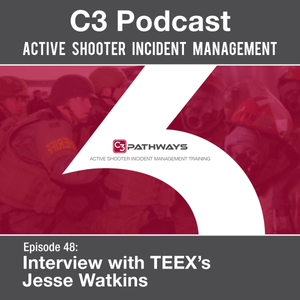
Ep 48: Interview with TEEX's Jesse Watkins
C3 Podcast: Active Shooter Incident Management
10/11/21 • 39 min
Episode 48: Interview with TEEX's Jesse Watkins
On this week's podcast we have our sponsor of the Active Shooter Incident Management Advanced and Intermediate courses, TEEX's Jesse Watkins. In this episode we talk about the courses and training available to the first responder community.
Bill Godfrey:
Welcome to the Active Shooter Incident Management podcast. My name is Bill Godfrey, your podcast host. We have a special guest with us today. Today, we have Jesse Watkins, the director of operations for NERRTC. That's the National Emergency Response and Recovery Training Center over at TEEX out in Texas. Jesse, thanks for joining us today.
Jesse Watkins:
Oh, it's my pleasure Bill. Thank you for having me.
Bill Godfrey:
So obviously NERRTC and TEEX are the sponsors of the Active Shooter Incident Management advanced and intermediate courses that we developed that is DHS funded. And people who've heard me tell this story before, it's a little convoluted, the money flow, but it DHS to NERRTC to or, DHS to TEEX NERRTC, then over to ALERRT and then over to us to go out and do the classes. But Jesse, it's actually a little more complicated than that, isn't it? Tell everybody a little bit about how the structure works and how the pieces fit together.
Jesse Watkins:
It is a little bit more complicated than that. For those of you that don't know a whole lot about who TEEX is or who NERRTC is, TEEX is an agency within the state of Texas or for the state of Texas, and it's within the Texas A and M University System, which is comprised of 11 universities and now eight state agencies. And our primary mission is an extension. And within that extension, training, and in some cases, exercise. Back in 1998, as a result of the Oklahoma City bombing, we solicited Congress as a part of an organization called the NDPC, National Domestic Preparedness Consortium, for funding to go out and do online security training around the country. At the time that funding came on to DOJ and then after 9-11, it moved under Homeland Security with FEMA being the oversight organization, it was the checks and balances for what we do and how we spend the money that being said, NERRTC proper, National Emergency Response Recovery Training center, has 73 courses that we've developed under our funding to go out and train first responders, elected officials, a whole host of organizations.
But you know, our primary mission is incident management, cyber security, critical infrastructure, and several other areas. I won't go into all of them, but a lot of resources, put it that way, that we pour towards going out and doing training at no cost to participants or to the jurisdictions that's requesting it. As a result of that, a few years back, we started looking at the active shooter situation that was going on in the country. Obviously, Bill, you and I had conversations at the time. Steve, in a different capacity, and I had conversations at the time and agreed that we would like to be able to fund doing some active shooter training around the country. And you obviously had the course resources in terms of going out with the materials, going and doing the deliveries. We had some funding that we could put behind that, but it's under our DHS funding.
And what was born out of that is this relationship where we have now in which we subcontract to ALERRT and then ALERRT in turns, subcontracts to you. That being said, the relationship works. It is a little cumbersome. You know, when you stop thinking about how many different organizations it's taken to get this done, but we have figured out a way to make that effective and efficient over the years. And I'm happy about the relationship. That being said, the mission is the thing that's the most important piece to me. Going out and observing you all do this training obviously brings me a lot of satisfaction and that satisfaction is in knowing that we are training that first response community to be better and to react and respond better to active shooter situations and also to extrapolate out of that, using what they use in the classroom during this training and other scenarios as well.
I think it makes them more effective as a operational unit by the time they're done with it. So, I love that aspect of it. That's, that's really the driver for me. But when you stop and think about NERRTC or I can explain a little bit about NERRTC, most of the training that we do, we do in-house meaning we have SMEs and full-time staff that are devoted to doing nothing but delivery of those courses that I mentioned before.
So this relationship that we have with alert and with you is, it's not unique because we do have one other subcontractor that we work with that has a similar relationship, but it is out of the ordinary for what we typically do. We have roughly 80 full-time staff an...
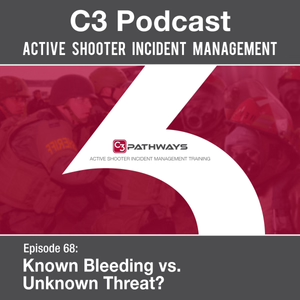
Ep 68: Known Bleeding vs Unknown Threats?
C3 Podcast: Active Shooter Incident Management
02/19/24 • 29 min
90% of the time the active threat is over within 10 minutes. In today’s episode we tackle the question of when is it time to stop searching for an unknown threat and when is it time to start focusing on medical? When the bad actor has gone silent, it’s time to coordinate resources and stop the known bleeding.
Watch this episode on YouTube at https://youtube.com/live/_NVp91myDsk
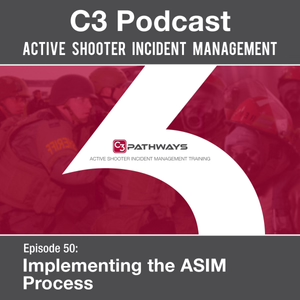
Ep 50: Implementing the ASIM Process
C3 Podcast: Active Shooter Incident Management
08/01/22 • 48 min
Ep 50: Implementing the ASIM Process
Sheriff Michelle Cook and Police Chief Terry Nichols share their experiences implementing the Active Shooter Incident Management Checklist process and their tips for success. Don't miss this discussion!
Bill Godfrey:
Welcome to the Active Shooter Incident Management Podcast. It's good to be back with you today. My name is Bill Godfrey. I'm your podcast host, and I have with me today two former C3 instructors as our guest stars today, both of them law enforcement leaders, and hoping that one day when they do retire-retire, we might actually get them back as C3 instructors; hint hint, Chief Nichols, who just retired in the last few weeks. So I have with me Michelle Cook. She is currently serving as the Sheriff in Clay County. She also did ... Michelle was almost 30 years at Jacksonville?
Michelle Cook:
26 years at Jacksonville, yeah.
Bill Godfrey:
Yeah, so 26 years at Jacksonville Sheriff's Office Police Department as the operations chief, so she had an awful lot of responsibility there. Did a short stint as the Police Chief at Atlantic Beach, which was kind of a retirement job, but too easy for you. You needed something with more, and so now she's the elected Sheriff at Clay County, which is in north Florida. And we have with us Terry Nichols. Terry was the Assistant Director at Alert from the founding to, what was it? 2018, 20-
Terry Nichols:
2016, 2016.
Bill Godfrey:
2016. Left Alert, became the Police Chief in Brownwood, Texas, and then you did, what, a little over three years there?
Terry Nichols:
Three years there, and then moved to Seguin as chief, and spent three years there, and now I'm retired
Bill Godfrey:
Like a week and a half ago, two weeks ago? It's been pretty recent.
Terry Nichols:
It's been a month, it's been a month.
Bill Godfrey:
So it's exciting to have both of you here. I really appreciate you taking the time. I know the sheriff especially, you have a very busy schedule. But I wanted to have a podcast where we talk about implementing the Active Shooter Incident Management checklist and the process that goes with it. Because it sounds simple on the surface, and when you've gone through training, it's fairly straightforward, but trying to roll that out to a whole organization is a little bit of a logistics machine.
And the two of you have each done this, not only in your organizations, but you've done it more than once. So sheriff, you did it at Jacksonville, then did it at Atlantic Beach, now at Clay County, and Terry, you did it at both Brownwood and Seguin. So what I wanted to just get from you guys is, what was it about this process that made you say, "This is the way I want to go," and what were your lessons learned? How did you approach it and go along the way? So sheriff, you want to start us off?
Michelle Cook:
Sure. First of all, thank you for having me today to talk about this. I'm very passionate about this. You've asked why ASIM, why choose this method of managing an active shooter event, and I will tell you, I'm entering into my 30th year of law enforcement, and I've worked some huge cases, some huge incidents, thousands of them, and for me, being a street cop for so long and then the leader of street cops, the ASIM process, the ASIM methodology, it just makes sense.
In our industry, and Terry, correct me if you see differently, we teach young officers, young supervisors, to handle everything themselves. And on 99% of the calls that we handle, that can be done, but on a mass critical incident, like an active shooter event, relying on one person to handle everything is just unrealistic, and that's how things get missed, and unfortunately, that's how people die, is you got one person trying to handle everything.
Terry Nichols:
Yeah. For me, everything the sheriff said makes perfect sense, and she is spot on. Having been involved with Alert and standing it up from the get go, driving it post-Columbine, and how we were training cops, and then fast-forward several years and get introduced to the ASIM model, and realizing we had been missing the boat early on. When we started first training our officers, we were missing the management piece of this. We were doing good at going in and realizing that we have a different duty. There's no longer sit and wait for SWAT, that we had a different mission on these active shooter events.
But there's a whole management piece of this, and like the sheriff alluded to, that we're real good at teaching cops to go handle a problem by themselves, and they do it 9 times out of 10, but these events are catastrophic. They are geographical in nature. It doesn't just hap...
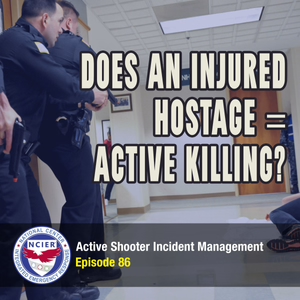
Ep 86: Injured Hostage Equals Active Killing
C3 Podcast: Active Shooter Incident Management
06/24/24 • 32 min
Our goal in an active shooter event is to stop the killing and stop the dying. If the shooting has stopped, but there are injured individuals in need of medical care being held hostage, is that still active killing? Today, Bill Godfrey, Billy Perry and Pete Kelting discuss this sensitive topic. Without the benefit of hindsight, decisions must be based on the current situation and evaluated according to the Safety Priority Tactical Action Evaluation (c3.cm/life).
View this episode on YouTube at https://youtu.be/ijIyMojNzlA
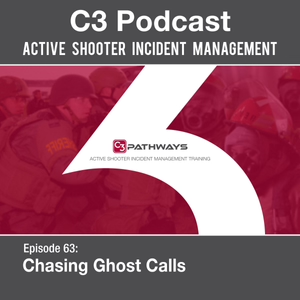
Ep 63: Chasing Ghost Calls
C3 Podcast: Active Shooter Incident Management
01/15/24 • 36 min
Today we touch upon some common occurrences in Active Shooter Events where follow-on 911 calls report additional shooters in differently locations but in reality are not accurate. These calls -- though well intended -- often result in duplicate work, wasted resources, or over-response to a new location. Active Shooter Events have one shooter 97% of the time, but our training teaches the "plus one" theory that we should always expect another bad guy. If you don't manage it, you will spend valuable time and resources chasing ghosts.
Watch this episode on YouTube at https://youtube.com/live/NbApXhCQhVo
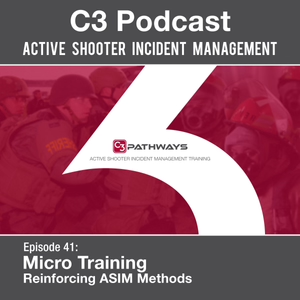
Ep 41: Micro Training
C3 Podcast: Active Shooter Incident Management
07/26/21 • 35 min
Episode 41: Micro Training
For this week's podcast topic, we discuss different types of micro training to help reinforce active shooter incident management methods.
Bill Godfrey:
Welcome to the Active Shooter Incident Management Podcast. My name is Bill Godfrey your podcast host. We're happy to have you with us today, where we're going to be talking about micro training. Things that you can do in 10 to 15 minutes during your roll calls or briefings to help people stay on top of Active Shooter Incident Management. I have with me today, three of the other instructors from C3 Pathways, Robert McMahon from the law enforcement side. Robert. Good to see you.
Robert McMahan:
Good to see you, Bill.
Bill Godfrey:
All right. We've also got Mark Rhame on the fire/EMS side, Mark. Good to have you back.
Mark Rhame:
Yeah, always enjoy it.
Bill Godfrey:
And Billy Perry, Billy it's been a little while.
Billy Perry:
It hasn't been. It's been a minute, but I'm glad to be back.
Bill Godfrey:
Oh, it's good to have you. Good to have you back in the house. All right. So I almost feel like the first thing I want to do is go around and talk about all the different names we've heard this called. So roll call training, briefing training, quick drills. What else?
Robert McMahan:
Seven minute training where I came from.
Bill Godfrey:
Seven minute training. Okay.
Mark Rhame:
Morning teleconference review issues. Yeah.
Billy Perry:
Hip pocket training.
Bill Godfrey:
Hip pocket. All right. So the idea here is that during these opportunities, whether it's roll call, shift change, whenever you're going to do it within your organization, to be able to take 10 or 15 minutes and kind of reinforce some of these ASIM topics. And so I've asked the instructors to kind of come up with some things that they thought would help. And some of these are things that you can do really without any preparation, without any warning. Some of them are going to acquire a little bit of planning, but not a whole ton of planning. And we're going to kind of go through them. Mark. Do you mind leading us off?
Mark Rhame:
Sure. I guarantee you the three, four of us sitting here at this table and the people listening probably can go to their file cabinet, go to their book, whatever they keep their certificates of the classes they've taken, and they stick them into those files, stick them into that book. And then they pretty much ignore it from that point forward for the most part. Part of the failure, I guess, in the public safety environment, whether it's fire/EMS, law enforcement, is that we do a lot of good training. We get together and we come together and say this is a good thing, but how much do we practice this? How much do we talk about it? How much do we go out there and engage our partners? Whether if you're on the fire/EMS side or your talking to the law enforcement, especially the guys you run with, girls who run with on a regular basis than a community and talk about these topics and reinforce what we're going to do when we get on those scenes.
So one of the first things I look at is for fire and EMS is you need to invite your fellow law enforcement brothers and sisters out there stop by a firehouse. And let's re-emphasize what our roles are, what we're going to do when we get on the scene. When you build out an RTF how much equipment you're going to carry? Who's in command, who's going to do talking on the radio, make sure we have that radio discipline. So there's a lot of things that we can do in a very short period of time. But again, it's up to that battalion chief or assistant chief or whatever that ranking person is on that morning teleconference to say, "Hey guys and girls go out there and get with your brothers and sisters." On the law enforcement side as I'm talking about fire/EMS and let's reemphasize and talk about what our responsibilities are and what our roles are going to be in these environments. Because again, all of us has taken these classes, but how much do we practice it afterwards?
Bill Godfrey:
So real quick and simple Mark, you're talking about just invite your local law enforcement guys and gals that work in your area, ask them to come by pop by the firehouse 10, 15 minutes for a meal.
Mark Rhame:
A simple thing as open up the cabinet and show them what you're going to carry so they can actually see what your intent is when you arrive on the scene at staging, and you build out your RTFs-
Billy Perry:
And what your ability is.
Mark Rhame:
Show more best episodes

Show more best episodes
FAQ
How many episodes does C3 Podcast: Active Shooter Incident Management have?
C3 Podcast: Active Shooter Incident Management currently has 112 episodes available.
What topics does C3 Podcast: Active Shooter Incident Management cover?
The podcast is about Law Enforcement, Cop, Ems, Paramedic, Podcasts, Fire, Education, Police and Firefighter.
What is the most popular episode on C3 Podcast: Active Shooter Incident Management?
The episode title 'Ep 20: Reunification with John-Michael Keyes, Part 1' is the most popular.
What is the average episode length on C3 Podcast: Active Shooter Incident Management?
The average episode length on C3 Podcast: Active Shooter Incident Management is 33 minutes.
How often are episodes of C3 Podcast: Active Shooter Incident Management released?
Episodes of C3 Podcast: Active Shooter Incident Management are typically released every 7 days.
When was the first episode of C3 Podcast: Active Shooter Incident Management?
The first episode of C3 Podcast: Active Shooter Incident Management was released on Jul 2, 2018.
Show more FAQ

Show more FAQ